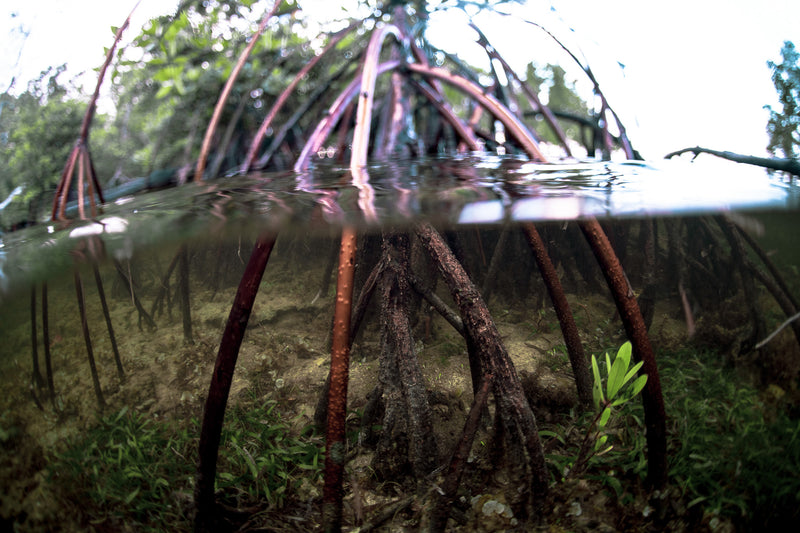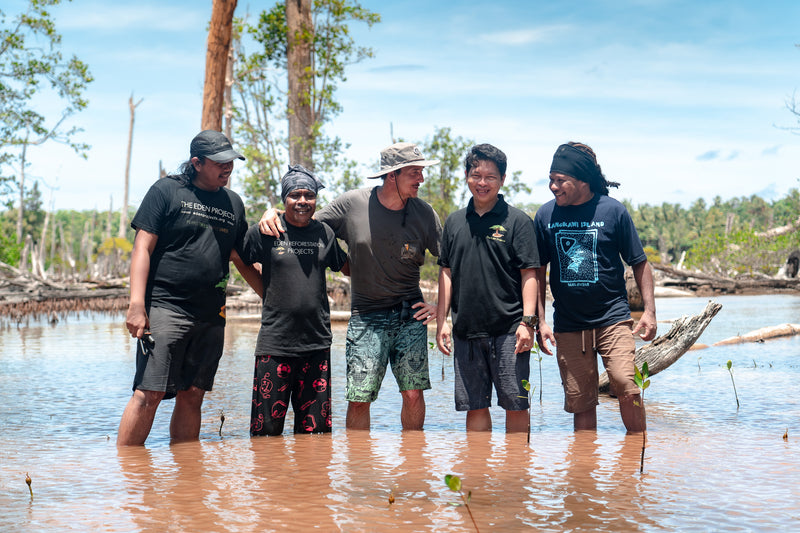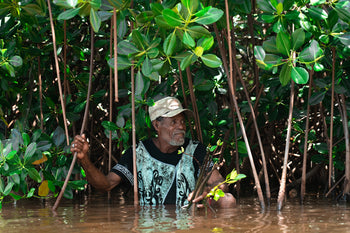4 Minuten Lesezeit
We’re on a mission to reduce our emissions. Not just to counterbalance them with carbon neutrality, but to proactively ensure they are lowered.
How do we plan to do this? By making better business decisions to effectively reduce our emissions over time, whilst also helping nature restoration projects in the sea and on the shoreline, such as mangrove forest planting. It may initially sound unusual, but stick with us while we share how the power of mangroves helps to store carbon from the atmosphere.

The difference between carbon neutrality and reducing emissions
Carbon neutrality and offsetting can be a dangerous game as they can lead to no real reduction in emissions produced. Instead, it can create an opportunity to merely equalise emissions to the number of trees planted - which doesn’t change the emissions produced and therefore isn’t hugely helpful for the planet.

Understanding the power of blue carbon
Planting and protecting blue-carbon coastal ecosystems and supporting their communities is the most effective way to suck carbon out of the atmosphere. Why? Because it’s the fastest way to absorb CO2 in the world! Blue carbon ecosystems include mangrove and kelp forests, seagrass, coral reefs, and coastal watersheds.
However, 30-50% of blue carbon stores have been lost, with mangrove forests being cut down for shrimp and salt farming, the trees do not naturally grow back due to complete degradation of the soil and water.

The power of mangrove forests
Research suggests that 14% of all coastal carbon sequestration is due to mangrove forests, despite covering only 0.1% of the planet's surface.
But storing carbon isn’t the only benefit of planting mangroves. Their roots hold soil together, helping to prevent erosion and protecting local communities against the impact of storm surges and rising sea levels. Complex mangrove root systems also filter pollutants from the water (like nitrates and phosphates), improving the water quality flowing from rivers into the ocean.
Additionally, mangroves help support biodiversity by providing habitat and nursery grounds for wildlife such as birds, fish, invertebrates, animals and plants.

How we’re supporting mangrove restoration
SeaTrees, by the non-profit Sustainable Surf, supports both people and the ecological systems they live in by restoring, replanting, and protecting blue-carbon coastal ecosystems across the planet.
We share their love of the ocean and are supporting the mission to take direct action on climate change by planting just under 13,000 mangrove trees - 12,657 to be precise. The project is restoring and protecting 46 hectares of highly degraded mangrove forest where 75% of the estuaries are deforested.
In addition to this, the plantation of mangrove forests requires not only jobs in planting roles but also as tree guardians to the local community. In numbers, 10 mangrove trees provide approximately 1/2 day of living-wage employment for the local community members, helping to support 55 families.

Facts, figures, and benefits of mangrove forests
For every 10 mangrove trees planted, they can potentially sequester more than 3 metric tons of carbon dioxide over a 25-year life span.
Sequestering carbon dioxide aside, the plantation of mangrove forests has a domino effect on the local environment. It creates nesting, breeding, and nursery habitats for fish, shellfish, migratory birds, and sea turtles.
As a result, it also increases fish stock, which supports local fishing communities with an increase in yields.
It also maintains water quality by trapping sediments and pollutants with their roots, protects other fragile ecosystems downstream, and acts as a natural coastal defence against tsunamis, tropical storms, storm surges, and sea-level rise.
Find out more about the project by visiting seatrees.org
Facebook: Sea Trees
Instagram: @sea.trees
X: @sustainsurf
LinkedIn: Sea Trees
YouTube: @SeaTreesbySustainableSurf
#dryrobeterritory
Published on March 27, 2024
